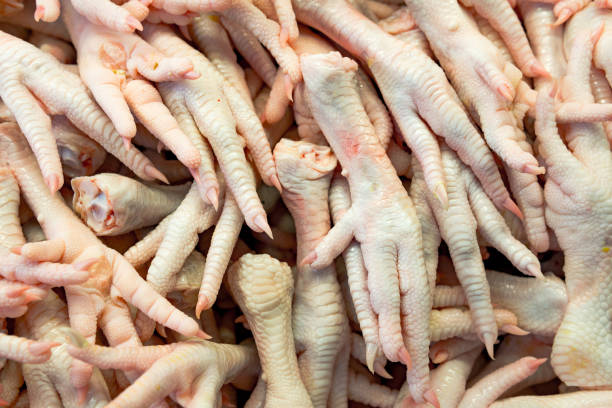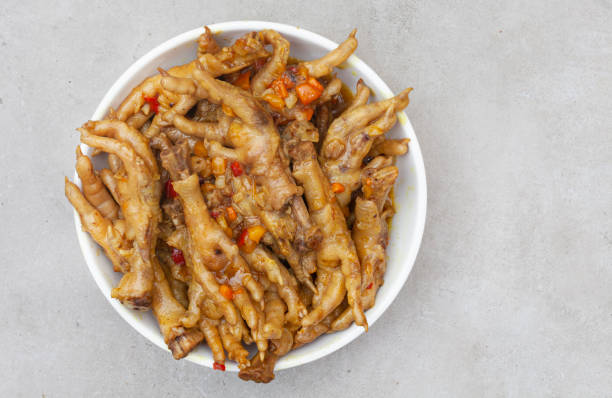Are Chicken Feet Good for Dogs? Benefits, Drawbacks, and More

Yes, Chicken Feet Good for Dogs. As they provide various health benefits. They are rich in glucosamine, chondroitin, and collagen, which are essential for joint health and can help maintain strong bones and joints in dogs, especially as they age. Additionally, chicken feet are a natural source of protein and can contribute to a balanced diet for dogs. The chewing action required to eat chicken feet can also help promote dental health by reducing plaque and tartar buildup, leading to healthier teeth and gums. However, it’s essential to feed chicken feet in moderation and ensure they are cooked thoroughly to avoid any potential risks of bacterial contamination. As with any new food, it’s recommended to introduce chicken feet gradually into your dog’s diet and monitor for any adverse reactions. Overall, when fed as part of a balanced diet, chicken feet can be a nutritious and enjoyable treat for dogs.
Are Chicken Feet Good for Dogs?
Are Chicken Feet Good for Dogs?, Yes, chicken feet are good for Dogs. Chicken feet are a popular and readily available treat for dogs, but are they truly beneficial for our furry companions? In this article, we’ll delve into the question: Are chicken feet good for dogs? We’ll examine the potential benefits they offer, any associated risks, and how to safely incorporate them into your dog’s diet.
Benefits of Chicken Feet for Dogs
Chicken feet are a natural source of essential nutrients that can enhance your dog’s health in various ways. Firstly, they are rich in glucosamine and chondroitin, which are vital for maintaining healthy joints and cartilage. These compounds help reduce inflammation, alleviate joint pain, and improve mobility, making them particularly beneficial for senior dogs or those with arthritis or other joint issues. Additionally, chicken feet contain collagen, a protein that supports skin, coat, and nail health, giving your dog a shiny and lustrous appearance. Furthermore, the act of chewing on chicken feet helps promote dental health by reducing plaque and tartar buildup, preventing gum disease and bad breath. Moreover, chicken feet are a natural source of protein, aiding in muscle development, energy production, and overall nutrition for your canine companion.

The Role of Chicken Feet in a Balanced Diet
Incorporating chicken feet into your dog’s diet can provide valuable nutritional benefits and enhance their overall diet. However, it’s essential to do so in moderation and as part of a balanced diet. While chicken feet offer valuable nutrients like glucosamine, chondroitin, and collagen, they should not be the sole source of nutrition for your dog. Instead, they should complement a well-rounded diet consisting of high-quality commercial dog food or a balanced homemade diet. Additionally, it’s crucial to consider your dog’s individual dietary needs, age, size, and activity level when determining the appropriate portion size and frequency of feeding chicken feet. Consulting with a veterinarian or canine nutritionist can help ensure that your dog’s diet meets their nutritional requirements and supports their overall health and well-being.
Safety Precautions When Feeding Chicken Feet to Dogs
While chicken feet offer numerous health benefits, it’s essential to take some safety precautions when feeding them to your dog. Firstly, choose high-quality chicken feet from reputable sources to ensure they are free from harmful additives, contaminants, or preservatives. Thoroughly wash the chicken feet before serving to remove any dirt, bacteria, or residues. Cook the chicken feet thoroughly to eliminate any potential pathogens and reduce the risk of foodborne illnesses. Additionally, supervise your dog while they’re enjoying chicken feet to prevent choking or swallowing large pieces whole. Finally, feed chicken feet in moderation as part of a balanced diet, and monitor your dog’s reaction for any signs of allergies or digestive issues.

Disadvantages of Chicken Feet for Dogs
While chicken feet are often touted for their numerous health benefits for dogs, it’s essential to consider the potential drawbacks and risks associated with feeding them to your furry companions. In this article, we’ll delve into the disadvantages of chicken feet for dogs, including safety concerns, potential health risks, and dietary considerations.
Safety Concerns
One of the primary disadvantages of chicken feet for dogs is the risk of choking or gastrointestinal obstruction. Chicken feet contain small bones and cartilage that can pose a choking hazard, especially for smaller dogs or those prone to gulping their food without properly chewing. Additionally, if ingested in large pieces, chicken feet can potentially cause blockages in the digestive tract, leading to serious health issues that may require surgical intervention. To minimize these risks, it’s crucial to supervise your dog while they’re enjoying chicken feet and ensure they chew them thoroughly before swallowing.
Potential Health Risks
Another concern with feeding chicken feet to dogs is the potential risk of bacterial contamination. Raw chicken feet, in particular, can harbor harmful bacteria like salmonella, which can cause foodborne illnesses in dogs. Even cooked chicken feet may still carry some risk of bacterial contamination if not handled and stored properly. To reduce the risk of foodborne illness, it’s essential to thoroughly cook chicken feet before offering them to your dog and practice proper food safety measures, such as washing hands and surfaces after handling raw meat.

Dietary Considerations
While chicken feet offer some nutritional benefits, they should be fed in moderation and as part of a balanced diet. Feeding too many chicken feet can lead to dietary imbalances and digestive issues in dogs. Additionally, chicken feet are high in fat, which can contribute to weight gain and obesity if consumed in excess. It’s essential to consider your dog’s individual dietary needs, age, size, and activity level when determining the appropriate portion size and frequency of feeding chicken feet. Consulting with a veterinarian or canine nutritionist can help ensure that your dog’s diet remains balanced and nutritionally complete.
What About Cooked Chicken Feet?
Cooked chicken feet are a popular and readily available treat for dogs, often touted for their numerous health benefits. However, pet owners may have questions about the safety and suitability of feeding cooked chicken feet to their furry companions. In this article, we’ll delve into the topic of cooked chicken feet for dogs, examining their safety, nutritional value, and potential benefits.

Safety of Cooked Chicken Feet for Dogs
Cooked chicken feet are generally safe for dogs to consume, provided they are prepared and served correctly. Cooking chicken feet thoroughly helps eliminate harmful bacteria and reduces the risk of foodborne illnesses such as salmonella. However, it’s essential to ensure that the chicken feet are cooked adequately to avoid any potential health risks. Additionally, pet owners should avoid feeding their dogs seasoned or flavored chicken feet, as these may contain ingredients that are harmful to dogs, such as onions, garlic, or excessive salt.

The Nutritional Value of Cooked Chicken Feet
Cooked chicken feet are rich in essential nutrients that can benefit your dog’s overall health and well-being. They are an excellent source of protein, which is essential for muscle development, energy production, and overall nutrition. Additionally, cooked chicken feet contain glucosamine and chondroitin, compounds that support joint health and mobility, making them particularly beneficial for senior dogs or those with arthritis or other joint issues. Furthermore, the act of chewing on cooked chicken feet can help promote dental health by reducing plaque and tartar buildup, preventing gum disease and bad breath.
Potential Benefits of Cooked Chicken Feet for Dogs
Feeding cooked chicken feet to your dog can offer several potential benefits beyond nutritional support. The chewing action required to consume chicken feet can help satisfy your dog’s natural instinct to chew, providing mental stimulation and helping alleviate boredom and anxiety. Additionally, the rich flavor and texture of cooked chicken feet make them an enticing and enjoyable treat for dogs, making training and obedience sessions more effective. Furthermore, the act of chewing on cooked chicken feet can help strengthen your dog’s jaw muscles and promote overall dental health, reducing the risk of dental issues such as tooth decay and gum disease.

Comprehensive Guide to Chicken Feet for Dogs: Pros, Cons, and Considerations
Chicken feet have become increasingly popular as a natural treat for dogs, praised for their nutritional value and dental health benefits. However, pet owners often have questions about whether chicken feet are the right choice for their furry companions. In this comprehensive guide, we’ll delve into the pros, cons, and considerations of feeding chicken feet to dogs, helping you make an informed decision about whether they’re suitable for your canine friend.
Pros of Chicken Feet for Dogs
Nutritional Value
Chicken feet are rich in essential nutrients like protein, glucosamine, and chondroitin, which support muscle development, joint health, and overall well-being in dogs. The protein content in chicken feet helps maintain muscle mass and energy levels, while glucosamine and chondroitin promote healthy joints and mobility, making them particularly beneficial for senior dogs or those with arthritis.
Dental Health
Feeding chicken feet to dogs can improve dental health by reducing plaque and tartar buildup. The act of chewing on the tough, rubbery texture of chicken feet helps scrape away plaque from your dog’s teeth, preventing dental issues such as tooth decay, gum disease, and bad breath. Regular chewing also stimulates saliva production, which naturally cleanses your dog’s mouth and promotes oral hygiene.
Mental Stimulation
Chewing on chicken feet provides mental stimulation and helps alleviate boredom and anxiety in dogs. The repetitive action of gnawing on the tough texture of chicken feet engages your dog’s senses and provides a satisfying outlet for their natural chewing instincts. This can be particularly beneficial for dogs who suffer from separation anxiety or exhibit destructive chewing behavior.

All-Natural Treat
Chicken feet are a natural and minimally processed treat, making them a healthier alternative to commercially processed snacks that may contain additives, preservatives, or artificial ingredients. By opting for natural treats like chicken feet, you can provide your dog with a wholesome and nutritious snack that aligns with their evolutionary diet as carnivorous animals.
Cons of Chicken Feet for Dogs
Choking Hazard
One of the main drawbacks of feeding chicken feet to dogs is the risk of choking. Chicken Cons feet contain small bones and cartilage that can pose a choking hazard, especially for smaller dogs or those prone to gulping their food without properly chewing. To minimize this risk, it’s essential to supervise your dog while they’re enjoying chicken feet and ensure they chew them thoroughly before swallowing.
Digestive Issues
Feeding chicken feet to dogs in large quantities or without proper preparation can potentially lead to digestive issues such as gastrointestinal upset or blockages. The high-fat content of chicken feet can cause digestive upset in some dogs, particularly those with sensitive stomachs or dietary sensitivities. Additionally, if ingested in large pieces, chicken feet can potentially cause blockages in the digestive tract, leading to serious health issues that may require surgical intervention.
Bacterial Contamination
Like all raw meat products, chicken feet can harbor harmful bacteria such as salmonella, which can cause foodborne illnesses in dogs. To reduce the risk of bacterial contamination, it’s essential to handle and store chicken feet properly and ensure they are thoroughly cooked before feeding them to your dog. Additionally, pet owners should wash their hands and surfaces thoroughly after handling raw chicken feet to prevent cross-contamination.
Considerations for Feeding Chicken Feet to Dogs
Moderation
While chicken feet offer numerous health benefits for dogs, they should be fed in moderation as part of a balanced diet. Feeding too many chicken feet can lead to dietary imbalances and digestive issues in dogs. Additionally, chicken feet are high in fat, which can contribute to weight gain and obesity if consumed in excess. It’s essential to consider your dog’s individual dietary needs, age, size, and activity level when determining the appropriate portion size and frequency of feeding chicken feet.
Preparation
Before feeding chicken feet to your dog, it’s crucial to prepare them properly to minimize the risk of choking and bacterial contamination. Ensure that the chicken feet are thoroughly cooked and free from any harmful seasonings or additives before offering them to your dog. Additionally, always supervise your dog while they’re enjoying chicken feet and encourage them to chew thoroughly before swallowing.
Are chicken feet safe for dogs to eat?
- Yes, chicken feet are generally safe for dogs to eat when prepared properly. They provide a good source of protein and essential nutrients.
What are the nutritional benefits of feeding chicken feet to dogs?
- Chicken feet are rich in protein, glucosamine, and chondroitin, which support muscle development, joint health, and overall well-being in dogs.
Can chicken feet help improve my dog’s dental health?
- Yes, chewing on chicken feet can help reduce plaque and tartar buildup, promoting better dental hygiene and preventing dental issues such as tooth decay and gum disease.
Are there any risks or drawbacks associated with feeding chicken feet to dogs?
- While chicken feet offer many benefits, they can pose a choking hazard if not chewed properly and may contain harmful bacteria if not handled or prepared correctly.
How should I properly prepare and serve chicken feet to my dog?
- It’s essential to cook chicken feet thoroughly and remove any small bones or cartilage that could pose a choking risk. Offer them to your dog in moderation as part of a balanced diet.
Share this content:




https://quotesstorm.com/ what about this
ok
ok i will check